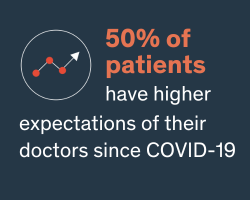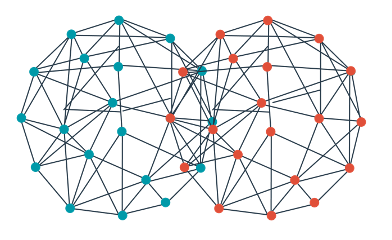To meet your population health goals, effective healthcare target audiences must consider the whole patient.
Healthcare providers of all specialties and sizes are experiencing similar challenges – how to move the needle on health quality metrics while continuing to manage budget constraints, maximize efficiencies, and drive revenue. As healthcare continues to evolve, the traditional approach is no longer viable. The crux of a new approach involves optimizing value for patients using effective healthcare target audiences while delivering the highest quality results at the most affordable cost.

In order to become and stay successful in this value-based environment, health systems and clinics must employ sophisticated target audiences and segmentation to facilitate targeted patient outreach and close key care gaps. The practice of grouping patients by level of risk can maximize provider time by prioritizing the highest value services – maximizing health outcomes and increasing efficiency.
Unfortunately, healthcare target audiences and outreach too often fails to take into account the whole picture of every patient. Targeting patients based on primary diagnosis, location, insurance, or demographics like age and sex fails to consider the patient’s unique desires, preferences, and behaviors.
The outcomes of patient outreach are only as successful as the inputs. Starting the process with a fine-tuned, targeted, and prioritized patient audience is the only way to ensure successful outreach efforts – outreach that drives conversions to appointments, boosts quality metrics, and increases overall value.
Better Communication with Healthcare Target Audiences

Patients are demanding better communication from their health care providers. In today’s post-covid environment, 50% of patients have increased demand for reliable information and communication from their doctors.
But all patient communications need to be highly relevant and actionable. Sending your maternity patients information about a new cardiology clinic or advertising a new primary care clinic to patients in another part of town only risks frustrating patients. It does little to engage patients in their care or build loyalty to your system or clinic.
Three key uses for building accurate healthcare target audiences include –
- Sending introductions to newly attributed patients. Reach out to patients as soon as they are assigned to your system or clinic to let them know their assigned provider name, clinic hours, phone number, etc.
- Providing relevant updates to existing patients. Let patients that are potentially at risk for specific conditions know about relevant new service lines or newly opened locations in their neighborhood.
- Prioritizing limited appointment inventory. Conduct outreach to your highest risk patients to make sure they get first priority on your limited appointment supply.
Why Manual Segmentation is Not Enough
Healthcare systems and clinics have been practicing patient audience segmentation for years in order to reach high-risk patients and close care gaps. It’s a critical population health technique to help patients manage their conditions and reduce costs to the overall health system.
According to BMC Health Services Research, “Segmentation is an approach that aims at the differentiation of groups of individuals into segments to align supply and demand and to facilitate the selection of the target groups.” Traditional healthcare audience segmentation considers basic factors like age and chronic disease diagnoses such as diabetes and hypertension.
This type of patient segmentation is a good first step to help you reach the highest-need patients and meet your health quality goals. However, what traditional patient segmentation does not consider – but should – is a holistic vision of a patient. It’s also critical to take into account limited appointment inventory with patient demand so that high-risk patients are able to receive services in a timely manner.
A Comprehensive Approach to Targeted Outreach
Effective patient outreach – outreach that reaches the right patient, at the right time, with the right action – takes into account more than simple demographics or diagnoses. It takes a complete picture of a patient and groups patients into highly targeted, prioritized patient audiences.
“Segmentation focused on changing behavior requires an understanding of how to influence people to take an action – for example, to choose to exercise, eat differently, or purchase goods and services. To date, this type of approach has been largely absent from discussions of population health,” states Wood et al. in Health Management, Policy, & Innovation.
Taking into account a more comprehensive view of a patient – including both clinical and engagement characteristics such as channels and prompts most likely to inspire action – results in better patient targeting. This leads to filling unused appointments with individuals that not only are at higher risk than others, but are more likely to respond, resulting in improved patient satisfaction and health outcomes. But how can health systems and clinics use the data they already have to develop this comprehensive viewpoint of every patient?

The Power of AI to Deliver Prioritized Healthcare Target Audiences
A typical patient produces around 80 megabytes a year in health data. That’s about 320 200-page books worth of data. Multiply that by years and years of records for every patient in the EHR, and the result is too much for most people to sort through. That is where artificial intelligence (AI) can produce extreme value.
“Efficient and effective application of data mining methods can aid the understanding of patient healthcare preferences,” according to Liu and Chen in International Journal of Health Care Quality Assurance. Each system and clinic’s EHR holds a treasure trove of data – and it’s data that goes beyond simple health diagnosis codes. AI learns as it grows, identifying the multiple combinations of patient characteristics that contribute to risk level, health preferences, likelihood of engagement, interest in self-management, and more.
Actium Health CENTARITM uses AI-driven models to deliver accurate and comprehensive patient audiences. Not only does it consider patient demographics, diagnosis, and other health-related factors, it takes the entire medical history – including over 10,000 different dimensions – to prioritize patients based on level of health need or risk as well as likelihood of engagement.
For example, CENTARI can identify patients in need of cardiology services, or patients who would benefit from a breast cancer screening. Then, as it sorts and prioritizes patient audiences, it also considers how likely a patient is to respond and take the next step such as scheduling an appointment. Watch the 40 second video below to see a visual of how this works.
Health system and clinic staff can manually filter by disease area, zip code, age group, primary care provider, and other factors. CENTARI’s sophisticated AI-propensity models take care of that and more, delivering a prioritized healthcare target audience that is updated in real time and can be directly communicated with via text message.
The beauty of using AI to develop patient audiences is that AI continues to learn and improve as it gathers more data over time. It can help systems and clinics significantly improve and scale their outreach efforts – from reaching only the highest risk patients with highly relevant and tailored messages.
Dynamic Throttling for Managing Appointment Capacity
Many health systems are experiencing limited appointment volume or more availability in specific service lines over others. This can make it extremely challenging to send campaign outreach to healthcare target audiences. You certainly don’t want someone to try scheduling an appointment only to find there aren’t any available or for an influx of calls to happen all at once, overwhelming the call center. You also don’t have the time to manually start and stop a campaign or validate appointment capacity in real time.
Alleviating this burden requires the use of always-on programs with the ability to dynamically throttle outreach based on appointment availability. Dynamic throttling takes into account appointment capacity and automates the outreach accordingly. If the health system has appointment inventory, then communications will continue. As appointment volume inventory becomes scarce, it will slow or stop the volume of outreach. Outreach programs can remain “on” without the concern of dissatisfied patients. Continuously reach the right target audience using both AI and dynamic throttling to drive a smoother, more predictable revenue stream.
As patient communications go out – and patients respond with and interact to messages – CENTARI learns more about each patient's preferences and behaviors. As a result, CENTARI conversion rates are up to 3X greater than the industry average because it gets the right messages to the right patients.
As providers continue adapting to a new value-based care environment, conducting targeted patient outreach becomes more and more critical. AI has the power to transform your patient targeting to reach the right patients, at the right time, with the message by way of comprehensive patient audiences.


